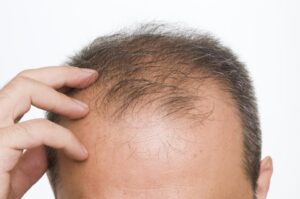Hair cycle and hair fall
the hair cycle
Referring to the scalp hairs, 85-90% of the- hairs are in anagen or growth stage which last from 2-6 years. This is followed by the catagen< 1 %) or degenerative stage for 2 weeks when there is apoptosis of the entire transient portion of the hair follicle. Every part of the transient portion is resorbed except for the glassy membrane. Then, the hair goes into telogen (nearly 13 %) or resting stage for 3 months before it is shed off.
– The anagen stage is subdivided into stage I to V i.e. proanagen stage according to the level of the hair tip of a new hair shaft as it grows progressively higher in the follicle. The meta-anagen stage or stage VI is when the hair shaft emerges above the skin surface.
-Except for male beard, the hair cycle in other area last for only months.
-Scalp hair grows at the rate of 0.35-0.37 mm. per day.
-Telogen hair never brows longer. It has a club -shape proximal end and is shed off by itself (new hair shaft does NOT push out the previous telogen hair). The inner root sheath is totally absent at this stage.
Distribution of hairs
– Most dense is the scalp follicles: 1135/cm2 at birth, 795/cm2 at the end of the first year and
11
615/cm2 by the third decade
– Average normal density of follicles on an adult scalp is 310-500/cm2
– Number of hairs is 170-250/ cm2 in prepubertal children
– Total number of follicles on the scalp in brown and black hair is 100,000 follicles. 10% less in red hair. 10% more in blond hair.
-Normal hair shedding is 100scalp hair per day
– In fetal life, hairs grow in wave pattern. By the end of the postnatal year, hair growth becomes mosaic pattern.
There are many types of hair loss. It is often categorized according to when it takes place during the hair growth cycle: anagen, catagen, and telogen.
The anagen phase is when your hair grows—your hair follicle forms a new hair shaft. Most (90%) of the hair on your scalp is in a growing phase that lasts from 2 to 6 years.
The catagen phase follows the anagen stage. This is a 1- to 2-week transition stage between anagen and telogen. Less than 1% of your scalp hair is in this phase.
The telogen stage is the rest stage. At the end of this 3- to 4-month phase, some of your hair falls out. Losing up to 100 hairs a day is normal. When a hair falls out, a new hair is grown in the same hair follicle, and the growing cycle begins again.
Androgenetic alopecia is inherited hair loss. In this type of hair loss, the growth (anagen) cycle becomes shorter and shorter. The hair follicles sprout hairs that are thinner than normal. The hairs become thinner and thinner, and eventually the follicles wither away.
Alopecia areata is a type of hair loss that is caused when the immune system mistakenly attacks hair follicles. This type of hair loss begins to get worse when hair follicles enter the rest (telogen) phase too soon.
Telogen effluvium has many causes. In this type of hair loss, large numbers of hairs enter the resting phase (telogen), which causes shedding and thinning. Usually no more than 50% of the hair is affected, and hair loss may occur up to 3 months after the event that causes it.footnote1 Causes include:
Mental stress or physical stress, such as recent surgery, illness, or high fever.
Poor nutrition, especially lack of protein or iron in the diet.
Side effects of medicines, such as blood thinners (anticoagulants).
Changes in hormone levels, such as those that occur after childbirth, when taking birth control pills, or at menopause.
Two types of hair loss not related to the hair growth cycle are trichotillomania and traction alopecia.
Trichotillomania is a compulsive behavior in which a person pulls hair out of the scalp, eyelashes, or eyebrows. There is usually mounting tension before pulling the hair and a feeling of relief afterward.
Traction alopecia involves hair loss around the edge of the hairline and is especially noticeable around the face and forehead. It is caused by your method of hairstyling. Certain hairstyles can pull hair too tight; for example, tight braids or tight ponytails can cause hair loss.



